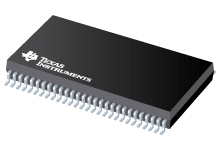Datasheet Texas Instruments 74ACT16861 — Ficha de datos
| Fabricante | Texas Instruments |
| Serie | 74ACT16861 |

Transceptores de bus de 20 bits con salidas de 3 estados
Hojas de datos
20-Bit Bus Transceivers With 3-State Outputs datasheet
PDF, 304 Kb, Revisión: B, Archivo publicado: nov 1, 1996
Extracto del documento
Precios
Estado
| 74ACT16861DL | 74ACT16861DLR | 74ACT16861DLRG4 | |
|---|---|---|---|
| Estado del ciclo de vida | Activo (Recomendado para nuevos diseños) | Activo (Recomendado para nuevos diseños) | Activo (Recomendado para nuevos diseños) |
| Disponibilidad de muestra del fabricante | No | No | No |
Embalaje
| 74ACT16861DL | 74ACT16861DLR | 74ACT16861DLRG4 | |
|---|---|---|---|
| N | 1 | 2 | 3 |
| Pin | 56 | 56 | 56 |
| Package Type | DL | DL | DL |
| Industry STD Term | SSOP | SSOP | SSOP |
| JEDEC Code | R-PDSO-G | R-PDSO-G | R-PDSO-G |
| Package QTY | 20 | 1000 | 1000 |
| Carrier | TUBE | LARGE T&R | LARGE T&R |
| Device Marking | ACT16861 | ACT16861 | ACT16861 |
| Width (mm) | 7.49 | 7.49 | 7.49 |
| Length (mm) | 18.41 | 18.41 | 18.41 |
| Thickness (mm) | 2.59 | 2.59 | 2.59 |
| Pitch (mm) | .635 | .635 | .635 |
| Max Height (mm) | 2.79 | 2.79 | 2.79 |
| Mechanical Data | Descargar | Descargar | Descargar |
Paramétricos
| Parameters / Models | 74ACT16861DL | 74ACT16861DLR | 74ACT16861DLRG4 |
|---|---|---|---|
| Bits | 20 | 20 | 20 |
| F @ Nom Voltage(Max), Mhz | 90 | 90 | 90 |
| ICC @ Nom Voltage(Max), mA | 0.08 | 0.08 | 0.08 |
| Operating Temperature Range, C | -40 to 85 | -40 to 85 | -40 to 85 |
| Output Drive (IOL/IOH)(Max), mA | -24/24 | -24/24 | -24/24 |
| Package Group | SSOP | SSOP | SSOP |
| Package Size: mm2:W x L, PKG | 56SSOP: 191 mm2: 10.35 x 18.42(SSOP) | 56SSOP: 191 mm2: 10.35 x 18.42(SSOP) | 56SSOP: 191 mm2: 10.35 x 18.42(SSOP) |
| Rating | Catalog | Catalog | Catalog |
| Schmitt Trigger | No | No | No |
| Technology Family | ACT | ACT | ACT |
| VCC(Max), V | 5.5 | 5.5 | 5.5 |
| VCC(Min), V | 4.5 | 4.5 | 4.5 |
| Voltage(Nom), V | 5 | 5 | 5 |
| tpd @ Nom Voltage(Max), ns | 11.1 | 11.1 | 11.1 |
Plan ecológico
| 74ACT16861DL | 74ACT16861DLR | 74ACT16861DLRG4 | |
|---|---|---|---|
| RoHS | Obediente | Obediente | Obediente |
Notas de aplicación
- Selecting the Right Level Translation Solution (Rev. A)PDF, 313 Kb, Revisión: A, Archivo publicado: jun 22, 2004
Supply voltages continue to migrate to lower nodes to support today's low-power high-performance applications. While some devices are capable of running at lower supply nodes others might not have this capability. To haveswitching compatibility between these devices the output of each driver must be compliant with the input of the receiver that it is driving. There are several level-translati - Introduction to LogicPDF, 93 Kb, Archivo publicado: abr 30, 2015
- Implications of Slow or Floating CMOS Inputs (Rev. D)PDF, 260 Kb, Revisión: D, Archivo publicado: jun 23, 2016
- CMOS Power Consumption and CPD Calculation (Rev. B)PDF, 89 Kb, Revisión: B, Archivo publicado: jun 1, 1997
Reduction of power consumption makes a device more reliable. The need for devices that consume a minimum amount of power was a major driving force behind the development of CMOS technologies. As a result CMOS devices are best known for low power consumption. However for minimizing the power requirements of a board or a system simply knowing that CMOS devices may use less power than equivale - Designing With Logic (Rev. C)PDF, 186 Kb, Revisión: C, Archivo publicado: jun 1, 1997
Data sheets which usually give information on device behavior only under recommended operating conditions may only partially answer engineering questions that arise during the development of systems using logic devices. However information is frequently needed regarding the behavior of the device outside the conditions in the data sheet. Such questions might be:?How does a bus driver behave w - Using High Speed CMOS and Advanced CMOS in Systems With Multiple VccPDF, 43 Kb, Archivo publicado: abr 1, 1996
Though low power consumption is a feature of CMOS devices sometimes this feature does not meet a designer?s system power supply constraints. Therefore a partial system power down or multiple Vcc supplies are used to meet the needs of the system. This document shows electrostatic discharge protection circuits. It also provides circuit and bus driver examples of partial system power down and curren
Linea modelo
Serie: 74ACT16861 (3)
Clasificación del fabricante
- Semiconductors> Logic> Buffer/Driver/Transceiver> Standard Transceiver